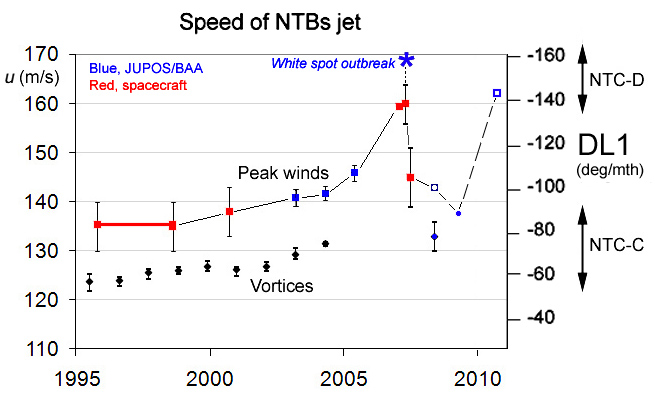| Possibility of a super-fast NTBs jetstream outbreak in 2011 by John H.Rogers |
Although all attention is now focussed on the reviving SEB, it is possible that the North Temperate Belt (NTB) could soon stage another great outbreak, as in 2007. This alert comes from analysis of the wind speeds by Grischa Hahn, who has shown that the NTBs jetstream has accelerated back to the super-fast speed that it had immediately before the 2007 outbreak.
Grischa has determined the zonal wind pattern over most of the planet, using a new correlation analysis program which he has written for WinJUPOS, and he has posted his first results (with text in German) at:
http://www.grischa-hahn.homepage.t-online.de/astro/winjupos/LongDrifts/index.htm . After a successful test run with New Horizons images from 2007, he analysed sets of images taken 10 hours apart on 2010 Sep.4 by Don Parker and Tomoyuki Yoshida. Although this is a preliminary result, which has yet to be confirmed from other image sets, it is a very complete zonal wind profile which agrees with the previous spacecraft data and with the fastest speeds obtained from JUPOS feature tracking in 2010 on NEBs (DL1 = -78 deg/mth, u3 = +143 m/s), and SEBn (DL1 = -111 deg/mth, u3 = +159 m/s),. Therefore, it is worth noting the speed that Grischa obtained for the NTBs jetstream at 24 deg.N: u3 = +162 m/s.
[u3 = eastward wind speed in System 3.]
A similar very rapid speed was also recorded in images from Voyager in 1979, and from New Horizons in 2007 Jan. Super-fast outbreaks with similar speed followed after one year in 1980, and after 2 months in 2007. The speed was much lower throughout the 1990s, as determined by HST and by the BAA: see attached chart (updated from:)
http://www.britastro.org/jupiter/2008report03.htm . It accelerated gradually from 2003 and then rapidly before the outbreak of 2007. This chart shows that the speed collapsed rapidly during the outbreak in 2007 (HST data from Sanchez-Lavega et al.), and remained in an intermediate state in 2008 and 2009 (our tracking of isolated features), and has now accelerated back to the pre-outbreak speed. Therefore, it seems probable that another great outbreak could occur in the near future.
These super-fast outbreaks occurred every 5 years from 1970 to 1990 (assuming one during solar conjunction in 1985), and the Voyager result showed that the jet was still in its super-fast state between outbreaks. It seems probable that the jet has now returned to the same state, and the next outbreak could occur 5 years after the last (i.e. in 2012), or quite possibly earlier (in 2011). Moreover, the south half of the NTB has been fading during the past year. Observers should be on the alert for a brilliant white spot appearing at 23-24 deg.N at any time.

John H. Rogers,Ph.D.
Jupiter Section Director,
[British Astronomical Association.]
●警告:2011年の超高速NTBsジェット気流outbreakの可能性 全ての注意が復活しているSEBに向けられているけれども、北温帯縞(NTB)はただちに 2007年のような新たなoutbreakの段階にあるかもしれない。この警告はGrischa Hahn による風速の解析に基づいていて、彼はNTBsジェット気流が2007年のoutbreak直前に 超高速に復帰して加速したことを示した。 Grischaは、WinJUPOSのために作成した新しい相関プログラムを使って、木星全体の 帯状風パターンを決定し、その最初の結果を公開している(ドイツ語)。 http://www.grischa-hahn.homepage.t-online.de/astro/winjupos/LongDrifts/index.htm 2007年のNew Horizonsの画像を用いたテストに成功してから、2010年9月4日に Don ParkerとTomoyuki Yoshidaによって10時間離れて撮影された画像セットを解析 した。これはまだ他の画像で確認しなければならない予備的な結果であるけれども、 過去の探査機データや、2010年にNEBs(DL1=-78度/月, u3=+143 m/s)とSEBn (DL1=-111度/月, u3=+159 m/s)に追跡されたJUPOSから得られた最速と一致する、 非常に完全な帯状風プロファイルである。従って、Grischaが北緯24度のNTBs ジェット気流で得た速度u3=+162 m/sは価値がある。 [u3=体系3での東向きの風速] 同様な非常に速い速度は、1979年のVoyagerと2007年1月のNew Horizonsの画像にも 記録された。同様な速度の超高速outbreakは1年後の1980年と2ヵ月後の2007年に 続いた。HSTとBAAによって決定されたように、1990年代の速度はもっと遅かった。 添付したチャートを参照(更新版)。 http://www.britastro.org/jupiter/2008report03.htm 2003年から次第に、それから2007年のoutbreakの前には急速に加速した。この チャートから、速度は2007年のoutbreakの間に急落し(Sanchez-Lavega等のHST データ)、2008年と2009年には中間状態のままであって(孤立した模様の我々の 追跡)、現在はoutbreak前の速度に戻って加速したことが分かる。したがって、 新たなoutbreakが近い将来に起こる可能性がある。 これらの超高速のoutbreakは1970年〜1990年には5年毎に発生したが(1985年には 合の間と仮定する)、Voyagerの結果からはoutbreakの間はジェット気流はなおも 超高速状態であったことが分かった。ジェット気流は現在同じ状態に戻っていて、 最後の発生の5年後(すなわち2012年)か、おそらくもっと早く(2011年)に、次の outbreakが発生する可能性がある。さらに、NTBの南半分は過去1年の間に淡化 している。観測者はいかなる時も北緯23-24度に出現する明るい白斑に注意を 払って欲しい。 John H. Rogers, Ph.D. Jupiter Section Director, British Astronomical Association 【日本語訳:伊賀祐一】
ALPO-Japan Latest
Jupiter Section